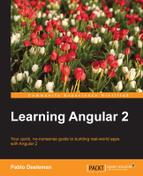We have now uncovered the power of the Angular router and we hope you have enjoyed this journey into the intricacies of this library. One of the things that definitely shines in the Router module is the vast number of options and scenarios we can cover with such a simple but powerful implementation.
In this chapter, we discussed how to install and provide support for routing in our applications and how to turn any given component into a routing component by decorating it with the router configuration decorator and placing a router outlet in its template, even spreading routers downward in the components tree. We also saw how to define regular routes and some other advanced types such as redirect or async routes. The routing lifecycle has no secrets for us anymore and harnessing its power will open the door to deliver advanced functionalities in our applications with no effort. The possibilities are endless and, most importantly, routing contributes to delivering a better browsing experience.
In the next chapter, we will beef up our task editing component to showcase the mechanisms underlying web forms in Angular 2 and what are the bests strategies to grab user's input with form controls.
